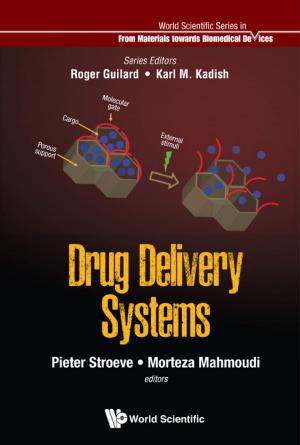Numerical PDE Analysis of the Blood Brain Barrier
Method of Lines in R
Nonfiction, Science & Nature, Science, Biological Sciences, Biology, Technology, Engineering, Health & Well Being, Medical| Author: | William E Schiesser | ISBN: | 9789813275812 |
| Publisher: | World Scientific Publishing Company | Publication: | December 21, 2018 |
| Imprint: | WSPC | Language: | English |
| Author: | William E Schiesser |
| ISBN: | 9789813275812 |
| Publisher: | World Scientific Publishing Company |
| Publication: | December 21, 2018 |
| Imprint: | WSPC |
| Language: | English |
The remarkable functionality of the brain is made possible by the metabolism (chemical reaction) of oxygen (O₂) and nutrients in the brain. These metabolism components are supplied to the brain by an intricate blood circulatory system (vasculature). The blood brain barrier (BBB), which is the central topic of this book, determines the rate of transfer from the blood to the brain tissue.
In particular, mathematical models are developed for mass transfer across the BBB based on partial differential equations (PDEs) applied to the blood capillaries, the endothelial membrane, and the brain tissue. The PDEs derived from mass balances and computer routines in R are presented for the numerical (computer-based) solution of the PDEs. The computed concentration profiles of the transferred components are functions of time and space within the BBB system, i.e., spatiotemporal solutions.
The R routines and the associated numerical algorithms for computing the numerical solutions are discussed in detail. The discussion is introductory, without formal mathematics, e.g., theorems and proofs. The general methodology (algorithm) for numerical PDE solutions is the method of lines (MOL).
The models are used to study the transfer of oxygen and nutrients, harmful substances that should not enter the brain such as chemicals and pathogens (viruses, bacteria), and therapeutic drugs. The intent of the book is to provide a quantitative approach to the study of BBB dynamics using a computer-based methodology programmed in R, a quality open-source scientific programming system that is easily downloaded from the Internet for execution on modest computers.
Contents:
- PDE Model Formulation
- PDE Model Computer Implementation
- Three PDE Models of Blood Brain Transfer
- Nonlinear PDE Models
- Multicomponent Blood Brain Barrier Models
- Application of Calibrated PDE Models to the BBB
Readership: Mathematical biologists, biochemists, biophysicists, applied mathematicians, numerical analysts, biomedical engineers, bioengineers, medical researchers, clinicians.
Key Features:
- Partial differential equation analysis describing the spatiotemporal dynamics of the BBB
- Availability of a series of tested, transportable, documented routines in R for the quantitative study of the BBB
- Application of mathematical models to study the effectiveness of the BBB in providing oxygen and nutrients, protection from harmful chemicals and pathogens, and therapy through drug delivery
- This combination of features does not appear in any other book of which the author is aware
The remarkable functionality of the brain is made possible by the metabolism (chemical reaction) of oxygen (O₂) and nutrients in the brain. These metabolism components are supplied to the brain by an intricate blood circulatory system (vasculature). The blood brain barrier (BBB), which is the central topic of this book, determines the rate of transfer from the blood to the brain tissue.
In particular, mathematical models are developed for mass transfer across the BBB based on partial differential equations (PDEs) applied to the blood capillaries, the endothelial membrane, and the brain tissue. The PDEs derived from mass balances and computer routines in R are presented for the numerical (computer-based) solution of the PDEs. The computed concentration profiles of the transferred components are functions of time and space within the BBB system, i.e., spatiotemporal solutions.
The R routines and the associated numerical algorithms for computing the numerical solutions are discussed in detail. The discussion is introductory, without formal mathematics, e.g., theorems and proofs. The general methodology (algorithm) for numerical PDE solutions is the method of lines (MOL).
The models are used to study the transfer of oxygen and nutrients, harmful substances that should not enter the brain such as chemicals and pathogens (viruses, bacteria), and therapeutic drugs. The intent of the book is to provide a quantitative approach to the study of BBB dynamics using a computer-based methodology programmed in R, a quality open-source scientific programming system that is easily downloaded from the Internet for execution on modest computers.
Contents:
- PDE Model Formulation
- PDE Model Computer Implementation
- Three PDE Models of Blood Brain Transfer
- Nonlinear PDE Models
- Multicomponent Blood Brain Barrier Models
- Application of Calibrated PDE Models to the BBB
Readership: Mathematical biologists, biochemists, biophysicists, applied mathematicians, numerical analysts, biomedical engineers, bioengineers, medical researchers, clinicians.
Key Features:
- Partial differential equation analysis describing the spatiotemporal dynamics of the BBB
- Availability of a series of tested, transportable, documented routines in R for the quantitative study of the BBB
- Application of mathematical models to study the effectiveness of the BBB in providing oxygen and nutrients, protection from harmful chemicals and pathogens, and therapy through drug delivery
- This combination of features does not appear in any other book of which the author is aware















